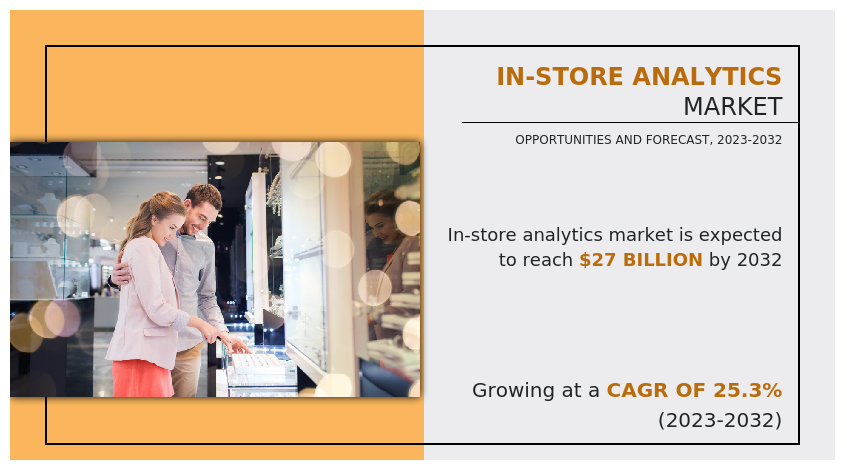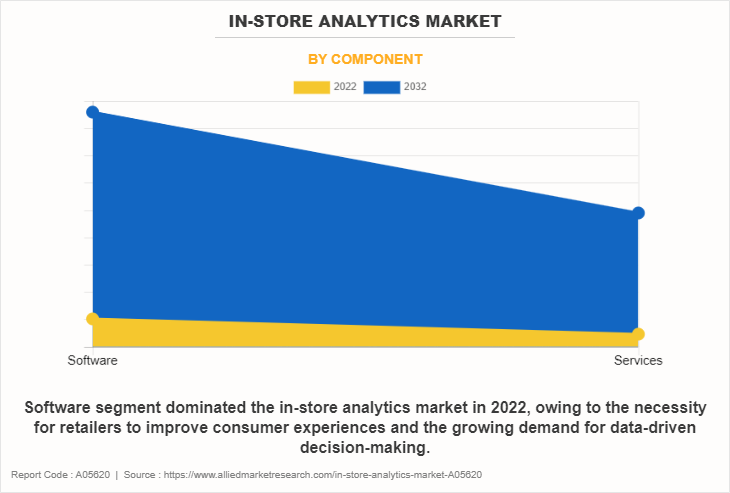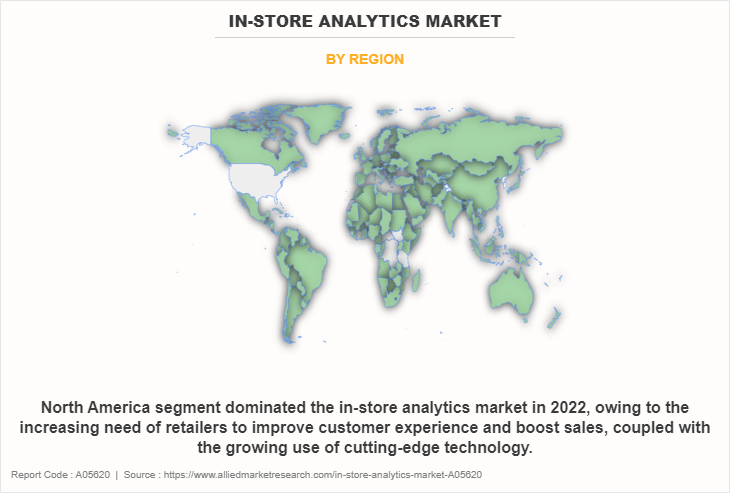In-Store Analytics Market Overview
The global in-store analytics market size was valued at USD 2.9 billion in 2022, and is projected to reach USD 27 billion by 2032, growing at a CAGR of 25.3% from 2023 to 2032.
Surge in strengthening the customer experience, rise in omnichannel integration, and an escalation of operational efficiency primarily drive the growth of the in-store analytics market. However, rising rise in security concerns and complexity of implementation hamper the market growth. Moreover, customized marketing strategies is expected to provide lucrative opportunities for the market growth during the forecast period.

Introduction
The in-store analytics market is a vibrant niche within the larger retail technology space with a focus on offering insights and intelligence drawn from data gathered within physical retail spaces. It includes a range of technical solutions intended to evaluate and understand different in-store data points, improving customer experiences, increasing operational effectiveness, and assisting merchants in making well-informed decisions. The fundamental idea behind the in-store analytics industry is to turn conventional brick-and-mortar stores into data-driven, intelligent locations. Moreover, to gather real-time data on consumer, foot traffic, product interactions, and other pertinent in-store activities, advanced technology like sensors, cameras, Wi-Fi tracking, and other Internet of things devices are used.
The market addresses the growing requirement for retailers to leverage data to stay competitive in a time when internet shopping and e-commerce provide major challenge for offline stores. With valuable insights similar to the data-rich environment of e-commerce platforms, in-store analytics solutions seek to close the gap between the online and offline retail experiences. The growing awareness that physical retail spaces can greatly benefit from data-driven insights, duplicating the capabilities of their online counterparts, is driving the market for in-store analytics. Through informed decision-making and improved operational efficiency, in-store analytics solutions play a critical role in helping retailers realize the full potential of retail as they strive to provide seamless, omnichannel experiences for customers.
Segment Overview
The in-store analytics market is segmented on the basis of component, enterprise size, deployment mode, application, and region. On the basis of component, it is divided into solution and services. On the basis of enterprise size, it is bifurcated into large enterprise and small and medium-sized enterprises. On the basis of deployment mode, it is bifurcated into on-premise and cloud. On the basis of application, it is fragmented into customer management, marketing management, merchandising analysis, store operations management, risk and compliance management, and others. Region-wise, it is analyzed across North America, Europe, Asia-Pacific, and LAMEA.
The report focuses on growth prospects, restraints, and analysis of the in-store analytics trend. The study provides Porter five forces analysis to understand the impact of numerous factors, such as the bargaining power of suppliers, the competitive intensity of competitors, the threat of new entrants, the threat of substitutes, and the bargaining power of buyers on the in-store analytics market share.

On the basis of component, software segment dominated the in-store analytics market in 2022 and is expected to maintain its dominance in the upcoming years owing to the necessity for retailers to improve consumer experiences and the growing demand for data-driven decision-making propels the market growth significantly. However, the services segment is expected to witness the highest growth, owing to rise in use of in-store analytics solutions by retailers and increase in demand for professional help in maximizing the potential of these solutions.

Region-wise, the in-store analytics market size was dominated by North America in 2022 and is expected to retain its position during the forecast period, owing to the increasing need of retailers to improve customer experience and boost sales, coupled with the growing use of cutting-edge technology aiding the growth of the in-store analytics market. However, Asia Pacific is expected to witness significant growth during the market forecast period, owing to the expanding retail industry and rise in use of cutting-edge technology which is expected to fuel the market growth in this region.
Key Market Players
In-store analytics key players such as RETAILNEXT, INC., AMOOBI, Trax Image Recognition, Teralytics Inc., Capillary Technologies, V-Count, SEMSEYE, HoxtonAi, Capgemini, and SAP. Furthermore, it highlights the strategies of the key players to improve the market share and sustain competition.
Top Impacting Factors
Strengthening Customer Experience
One key factor driving the in-store analytics market growth is the improvement of the customer experience. Retailers understand the critical role in-store analytics play in transforming the traditional shopping experience in an era where customer expectations are changing. This driving perfectly captures the strategic necessity of deploying data-driven insights to give customers a more efficient, engaging, and personalized experience. This trend is primarily driven by the significant influence that in-store analytics has on comprehending and reacting to consumer behavior. Retailers obtain real-time data on customer movements, preferences, and product interactions by implementing cutting-edge technologies such as sensors, cameras, and other Internet of things devices.
Since there is an abundance of information available, businesses may also design a shopping experiences that goes beyond transactional purchases. Retailers may optimize shop layouts based on real-time customer navigation patterns due to in-store analytics. It gives them the ability to arrange in-demand items strategically, make eye-catching displays, and improve the store's overall aesthetic appeal. Customers will find what they need more easily and enjoy a more seamless and delightful shopping experience as a direct result of this optimization.
Furthermore, one of the main characteristics of improving the customer experience with in-store analytics is personalized interactions. Retailers may offer discounts, and product suggestions according to past purchase and personal preferences of their customers. This degree of customization strengthens brand loyalty and raises the possibility of continued patronage by creating a feeling of connection between the consumer and the brand.
Rise in Omnichannel Integration
Thein-store analytics market is growing at an impressive rate, and one of the main factors driving this growth is omnichannel integration. In a time when customers purchase things both, online and offline with ease, businesses understand how important it is to provide a unified, consistent experience across all platforms. The strategic requirement of incorporating in-store data to close the gap between conventional retailers and the online world is achieved by in-store analytics. Retail industry response to the shifting consumer behavior landscape is at the core of this driver. Offering a unified and linked experience is becoming more important as consumers interact with brands through a variety of mediators, such as physical stores, online, and mobile apps.
The key to accomplishing this smooth integration is in-store analytics, which provides retailers with insights that are consistent and enhance the data-rich online environment. Retailers may dismantle archive between online and physical channels with the help of in-store data. Retailers collect data on customer behavior, preferences, and interactions within physical stores by utilizing technology like sensors, Wi-Fi tracking, and IoT devices. Then, by combining this data with online customer data, a comprehensive overview of each client across digital and physical channels is produced. In addition, one of the main features of omnichannel integration with in-store data is personalized experiences. Retailers use the collected data to give customers relevant and consistent experiences which raises the in-store analytics industry growth.
Recent Partnership in the Market
On October 2023, RetailNext, the leading in-store traffic analytics provider used by 450+ of the world's most loved brands, partnered with MarketDial, a prominent A/B testing solution for physical retail. This partnership aims to provide retailers with an unprecedented 360° view of the customer journey.
On January 2022, dunnhumby, the world leader in Customer Data Science, partnered with SAP, the market leader in enterprise application software, to help retailers integrate advanced customer insights into their marketing and merchandising programmes. The partnership allows retailers to make faster, customer-led decisions and deliver a more personalized shopper experience in-store and at home. Retailers will be able to better translate customer insights into clear actions to simplify and elevate everyday business processes and look ahead to build better connections as they prepare the future of retail.
On October 2020, RetailNext partnered with BrightSign, ConcretePlatform, Crave Retail, Creative Realities, Gaiadigits, MishiPay, Purple Wifi, Qudini, Radius8, StoreForce, Waitwhile, and Visionect. In addition to exciting customer growth, RetailNext announced several new partnerships, many leveraging the in-store occupancy data to provide consumers transparency to real-time in-store shopping environments as well as to build consumer-facing applications that leverage this data to create a more seamless experience.
On In November 2022, Manila-based F&B and retail management system provider Mosaic Solutions partnered with the Philippines largest shopping centre operator, SM Supermalls. The aim of this agreement is to deploy Mosaic advanced software across SM chain of 82 malls nationwide, facilitating advanced data insights and automation across a range of business areas, ultimately providing the tools to allow SM and its more than 20,000 tenants to improve their data-driven decision-making and operational efficiency.
Recent Agreement in the Market
On December 2022, SBLTY Groupe Technologies Corp., a leading software provider of security and retail analytics technology, signed a joint venture agreement with Business Platform Investment Holdings (BPIH), a division of Al Jabr Group, to bring digital out-of-home solutions and the Store as a Medium (SaaM) program, as well as their security solutions, to retail outlets, the oil and gas industry and smart cities in five Middle East countries.
Key Benefits for Stakeholders
This report provides a quantitative analysis of the market segments, current trends, estimations, and dynamics of the in-store analytics market analysis from 2022 to 2032 to identify the prevailing in-store analytics market opportunities.
The market research is offered along with information related to key drivers, restraints, and opportunities.
Porter's five forces analysis highlights the potency of buyers and suppliers to enable stakeholders make profit-oriented business decisions and strengthen their supplier-buyer network.
In-depth analysis of the in-store analytics market segmentation assists to determine the prevailing market opportunities.
Major countries in each region are mapped according to their revenue contribution to the global in-store analytics industry.
Market player positioning facilitates benchmarking and provides a clear understanding of the present position of the market players.
The report includes the analysis of the regional as well as global in-store analytics market trends, key players, market segments, application areas, and market growth strategies.
In-Store Analytics Market Report Highlights
| Aspects | Details |
| Market Size By 2032 | USD 27 billion |
| Growth Rate | CAGR of 25.3% |
| Forecast period | 2022 - 2032 |
| Report Pages | 378 |
| By Component |
|
| By Deployment Mode |
|
| By Enterprise Size |
|
| By Application |
|
| By Region |
|
| Key Market Players | SAP SE, Trax Image Recognition, RETAILNEXT, INC., Capillary Technologies, SEMSEYE, Teralytics Inc., Capgemini, AMOOBI, V-Count, HoxtonAi |
Analyst Review
The market for in-store analytics offers a strategic scope to transform the retail industry by utilizing the strength of data-driven insights in real-world retail settings. Retailers understand that in-store analytics is a critical component in transforming consumer experiences, increasing operational effectiveness, and maintaining competitiveness in a retail ecosystem that is changing quickly. In-store analytics is more than just a technology integration. Analyzing consumer behavior, foot traffic patterns, and interactions with merchandise can yield incredibly insightful information. Retailers are more equipped to make decisions that have a direct impact on the total retail experience and consumer satisfaction as a result. In-store analytics are seen by retailers as the key to smooth integration in the era of Omnichannel retail. Furthermore, a cohesive strategy where the online and offline shopping experiences intersect is facilitated by the insights obtained from in-store analytics. This is in line with the overarching organizational objectives of delivering a unified and consistent brand experience through all media. Retailers are aware of how in-store analytics revolutionize operational effectiveness. These technologies help create a leaner, more agile retail business by improving inventory management through data-driven insights and optimizing shop layouts based on foot traffic. Maintaining competitiveness and adjusting to shifting market needs depend heavily on this efficiency.
For instance, in October 2023, RetailNext, the leading in-store traffic analytics provider used by 450+ of the world’s most loved brands, partnered with MarketDial, a prominent A/B testing solution for physical retail. This partnership aims to provide retailers with an unprecedented 360° view of the customer journey. Harnessing its AI-powered heat-mapping technology, RetailNext pinpoints in-store foot traffic patterns, offering actionable insights such as dwell time, engagement metrics, and shopper exposure. By integrating this extensive data into MarketDial's platform, retailers can instantly establish in-store tests, while concurrently gauging shopper reactions to an array of stimuli. This joint offering positions retailers to unlock unparalleled insights into the evolving customer experience.
The In-Store Analytics Market was valued for $2,914.73 million in 2022 and is estimated to reach $26,948.25 million by 2032.
The In-Store Analytics Market is projected to grow at a compound annual growth rate of 25.3% from 2023 to 2032.
RETAILNEXT, INC., AMOOBI, Trax Image Recognition, Teralytics Inc., Capillary Technologies, V-Count, SEMSEYE, HoxtonAi, Capgemini, and SAP are the top companies to hold the market share in In-Store Analytics.
North America is the largest regional market for In-Store Analytics.
Strengthening The Customer Experience Strengthening the customer experience, rise in omnichannel integration, escalation of operational efficiency are the upcoming trends of In-Store Analytics Market in the world.
Loading Table Of Content...
Loading Research Methodology...



